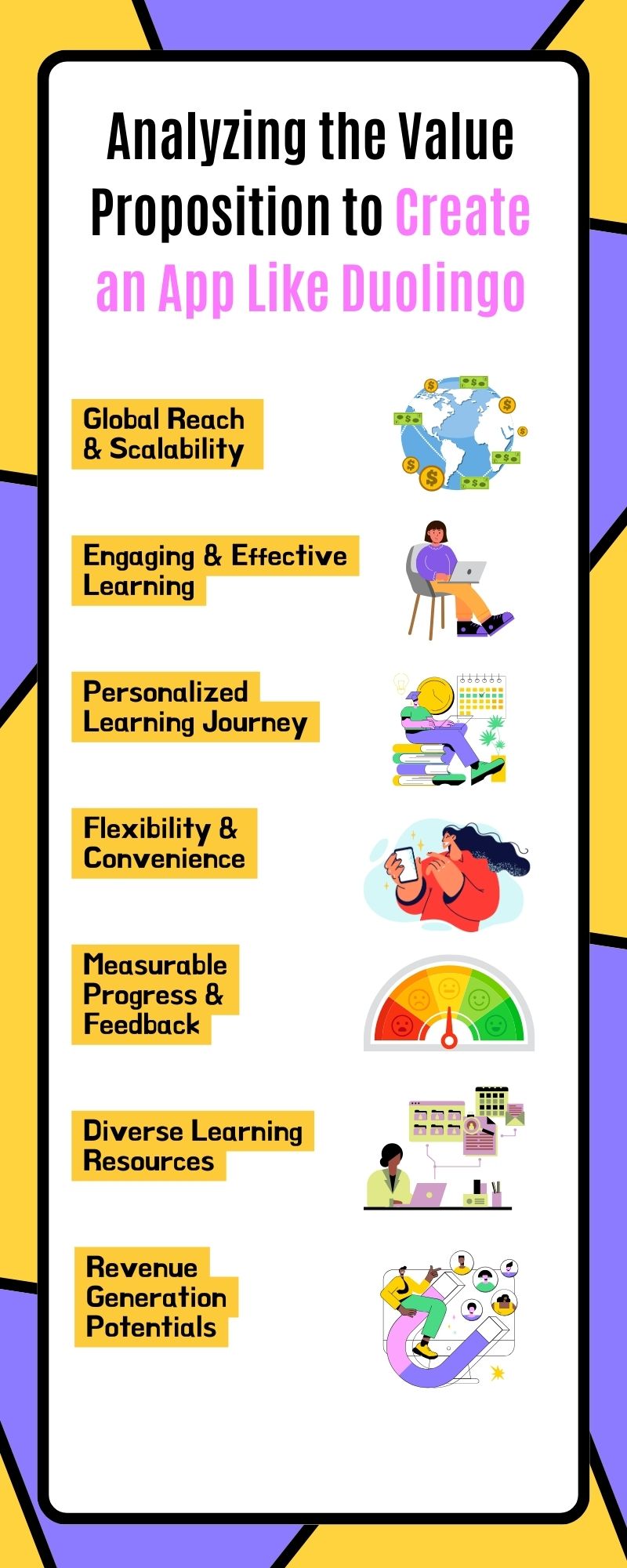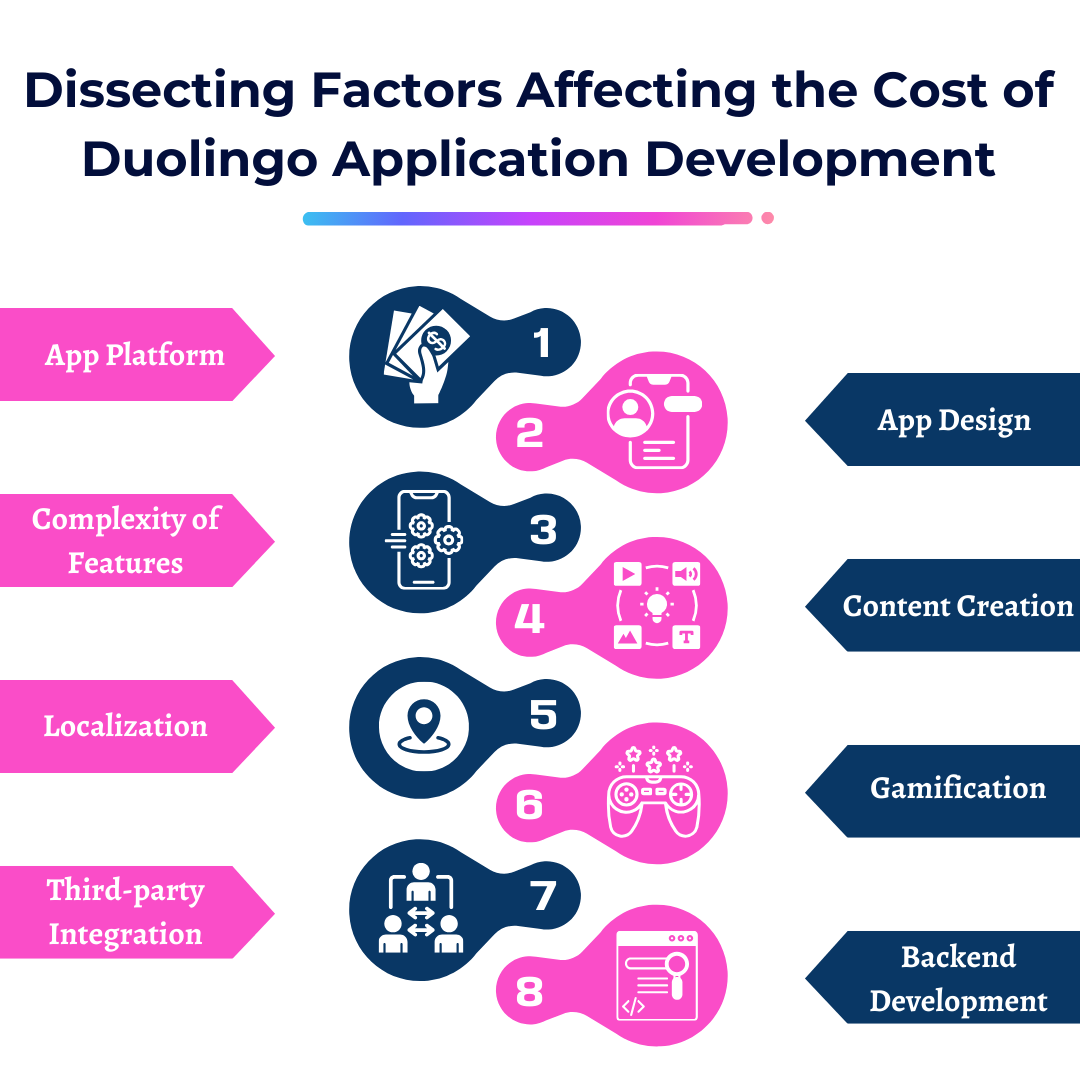Bonjour! Have you ever envisioned effortlessly conversing in a foreign language or landing that coveted job abroad? Undoubtedly, language barriers pose significant obstacles. The intricacies, lack of engagement, and restricted access to language learning resources can impede personal and professional advancement. However, fret not! Language learning apps like Duolingo are revolutionizing this journey with engaging content, personalized learning pathways, and multi-device accessibility.
The triumph of language learning softwares like Duolingo has ignited curiosity among numerous entrepreneurs. Yet, many are uncertain about seizing this opportunity and are eager to ascertain the costs of developing the Duolingo application. Rest assured, our team of skilled mobile app developers specializes in educational app development and offers comprehensive cost breakdowns at each developmental stage with absolute transparency. So, let’s delve deeper and explore the cost of Duolingo app.
Duolingo: Deconstructing a Language Learning Powerhouse
Duolingo isn’t just a language learning app; it’s a disruptive force in the education industry. Founded by visionary entrepreneurs Luis von Ahn & Severin Hacker, Duolingo leveraged cutting-edge technology and a freemium model to democratize language learning for millions worldwide.
- Worldwide, Duolingo has more than 500 million users in its learner community.
- It boasts a large user base, with 74.1 million monthly active users (MAU).
- Duolingo provides more than 100 courses for learning more than 40 languages.
| Duolingo Company Profile | |
| Launch Date | 30/ 11 / 2011 |
| Headquarter | Pittsburgh, Pennsylvania — USA |
| CEO | Luis von Ahn |
| Business Model | Freemium Model |
| Business Type | Public (NASDAQ: DUOL) |
| Industry | Language learning platforms |
Analyzing the Value Proposition to Create an App Like Duolingo
The language learning app market is booming, with the global eLearning market projected to reach $400 billion by 2026 (Statista). This presents a lucrative opportunity for entrepreneurs to create innovative solutions like Duolingo.
Furthermore, in Q2 2023, Duolingo generated around $126.8 million in revenue. Consider the following essential benefits if you want to create an app like Duolingo:

-
Global Reach & Scalability
Smartphones and internet access are becoming more and more common, anyone worldwide may use your app. As a result, you can assist a broader range of language learners, no matter where they are.
-
Engaging & Effective Learning
Gamification elements like challenges, rewards, and quizzes motivate learners to keep learning and improving. With the help of interactive features like vocabulary builders, pronunciation guides, and speaking exercises, users may actively engage in language learning.
-
Personalized Learning Journey
Users can set their own pace and focus on the subjects or language skills they want to focus on. Thanks to functionalities like progress monitoring and tailored recommendations, learners may customize the app to match their requirements and goals.
-
Flexibility & Convenience
The app’s accessibility allows users to incorporate language learning into their busy schedules anytime and from anywhere. Learners may interact with the application at their own leisure. This adaptability eliminates the limitations of traditional classroom-based education and boosts accessibility for a larger group of people.
-
Measurable Progress & Feedback
With language apps like Duolingo, learners may monitor their progress in real-time, get feedback on their areas of weakness, and trace their learning path. Students’ motivation is boosted by this instant feedback, which also enables them to gauge their own language proficiency.
-
Diverse Learning Resources
Many educational tools are available here, including audio files, interactive exercises, and vocabulary lists. Because of its adaptability, students can engage with the language in various ways that best fit their learning preferences and pedagogical approaches.
-
Revenue Generation Potentials
One possible business model is freemium, in which users can access essential functions without charge but have to pay for more advanced features or language courses. Also, partnerships with publishers, advertisers, and language schools can open new revenue streams.
How Much Does Duolingo Like App Development Cost?
An app like Duolingo can cost anywhere from $25,000 to $100,000 to develop if you want to stick to one platform, such as iOS or Android. Developing an app similar to Duolingo on a hybrid platform might cost between $75,000 and $150,000.
This is only a rough estimate of your Duolingo app cost. The range may vary comparatively based on the advanced tech stack, features, and functionalities used. Apart from that, a breakdown of all the factors should be considered, as unique factors impact the mobile app development costs.
| Task/ Features | Development Cost (in $) |
| Backend | $20-30,000 |
| Frontend (for app) | $15-20,000 |
| Content and exercises | $30-50,000 |
Dissecting Factors Affecting the Cost of Duolingo Application Development
Several variables are involved in developing language learning applications like Duolingo, which can impact the final cost. To efficiently distribute resources and make informed judgments, it is imperative to comprehend these elements. Let’s examine the critical factors:

1. App Platform and Development Methodology
You have to choose whether you want to go with native app development for iOS/Android or opt for cross-platform app development. Every platform offers benefits; however, you must consider things such as price and market penetration.
2. App Design
Its interface must be well-designed and easy to use for an effective language-learning app. Therefore, you should hire a UI/UX designer with experience to develop an app like Duolingo with a user-friendly, aesthetically pleasing interface that complies with user expectations and industry standards.
3. Complexity of Features
You have to determine the key features that apps for language learning like Duolingo, typically have. These are a few features of language courses —interactive lessons, vocabulary exercises, grammatical clarification, speech recognition, progress monitoring, and social elements.
4. Content Creation and Localization
It takes teamwork with native speakers, translators, and language experts to create high-quality language courses and content. Business owners must consider the expense of content production, localization, and regular updates to support several languages.
5. Gamification and Engagement
Achievements, leaderboards, badges, and prizes are examples of gamification aspects that can increase user motivation and engagement. Including these features could require investing more money and effort in development.
6. Integration with Third-party Services
The app’s functionality can be improved by integrating it with third-party services like social media sharing, translation APIs, and speech recognition APIs. It is feasible and cost-effective to incorporate these services into your language learning software with the help of an experienced education app development company.
7. Backend Development and Infrastructure
You must construct a secure, scalable backend infrastructure to manage users, deliver content, and handle user data. App owners should also consider the price of maintaining, hosting, and data storage needs for servers.
| Task/ Features | Development Cost |
| Documentation | $350-450 |
| UI design | $6,000-8,000 |
| Design implementation | $5,000-7,000 |
| Multiple resolution support | Depends on the app development company |
| Core logic | Depends on the app development company |
| Testing | $9,000-15,000 |
| App setup and launch | $5,500+ |
| Total | $30,000-$50,000 |
Also Read | Education App Development Guide
Essential Elements For a Duolingo-like App: Key Features for Language Learning Success
-
Interactive Lessons
Users should have access to engaging and interactive lessons incorporating elements like games, puzzles, and multimedia content.
-
Reading Comprehension
Include exercises that test reading comprehension skills to help learners develop their understanding of written language.
-
Writing Exercises
Providing opportunities for app users to practice writing in the target language helps solidify their grasp of grammar rules, sentence structure, spelling, etc.
-
Vocabulary Building
It should offer users various tools and exercises to expand their word bank, word lists, and contextual examples.
-
Listening Exercises
Incorporating listening exercises allows users to practice understanding spoken language, improve pronunciation, and develop auditory comprehension skills.
-
Speaking Practice
Speaking exercises, such as pronunciation drills, dialogue simulations, and speech recognition technology, enable users to practice speaking confidently and accurately.
-
Progress Tracking
Implement a progress tracking system to monitor learning milestones, track performance across different language skills, and set achievable goals for improvement.
-
Multi-Language Support
Offer support for multiple languages from diverse linguistic backgrounds so that users can easily access the app and learn the language of their choice.
-
Offline Mode
It allows users to download lessons, exercises, and resources for offline access, enabling uninterrupted learning even without an internet connection.
-
Quizzes
This feature helps users reinforce their learning, assess their comprehension of the material, and identify areas for improvement in a fun and interactive way.
-
Mobile Accessibility
Optimize the app for mobile devices so that users can learn on the go, access lessons anytime, anywhere, and switch between devices for a flexible learning experience.
-
Flashcards
This feature offers a simple yet effective way to review vocabulary, phrases, and grammar rules, facilitating quick memorization and retention of language concepts.
Also Read | How to Create an eLearning App like Byju’s
Next-Gen Features To Incorporate in Duolingo Like App Development
-
Speech Analysis
This feature allows users to receive feedback on their pronunciation, intonation, and fluency. It facilitates more accurate language learning and helps users develop their speaking skills.
-
Adaptive Learning
It enables the app to personalize the learning experience for each user based on their strengths, weaknesses, and learning pace, ensuring efficient progress.
-
Gamification Elements
Incorporating gamification elements like badges, rewards, leaderboards, and challenges enhances user motivation and makes learning more enjoyable.
-
Vocabulary Modules
This feature focuses on specific themes, topics, or industries. It allows users to expand their vocabulary in relevant areas of interest, catering to their unique learning needs.
-
Tailored Learning Paths
You can provide users with customized learning paths based on their proficiency level, learning objectives, and preferred learning styles.
-
Cultural Insights
Cultural insights, like customs, traditions, and idiomatic expressions, help users understand the target language’s cultural context.
-
Offline Accessibility
It allows learners to download content for offline use. This feature ensures uninterrupted learning even in areas with limited internet connectivity.
-
Grammar Guidance
This feature helps users understand grammar rules, usage, and exceptions. It enables them to communicate more accurately and confidently in the target language.
-
Conversational Exercises
With this feature, you can allow users to practice real-life communication scenarios, improving their speaking and listening skills in practical contexts.
-
Performance Analytics
This tool enables users to track their progress, identify areas for improvement, and receive personalized recommendations for further practice.
-
Social Networking Features
Incorporating features like language exchange forums, chat rooms, and discussion groups fosters a sense of community among users, encouraging peer interaction and collaboration.
-
Language Proficiency Certification
This feature allows users to validate their language skills and qualifications. It enhances their credibility and competitiveness in academic and professional contexts.
Also Read | Tutor Booking App Development
Navigating the Dynamic Trends of Language Learning App Development
Rapid technology improvements have significantly transformed the language learning environment. Creating language learning applications has become a significant trend, completely changing how people learn new languages.
The following are some of the latest language learning app development trends:
-
Artificial Intelligence (AI) and Machine Learning (ML)
Immersive language learning environments are being created through AR and VR technologies. By simulating real-world situations, these technologies can aid in language practice, the automated grading system to evaluate students’ work and provide them with personalized feedback.
-
Augmented Reality (AR) and Virtual Reality (VR)
Language learning app development now has more options thanks to AI and ML technologies. AI-driven chatbots and virtual tutors enable learners to practice their language skills realistically and dynamically by answering questions, simulating human-like interactions, and providing real-time feedback.
-
Voice Assistance and Smart Speakers
A growing number of voice-activated devices have led to integrating language learning softwares with services like Google Assistant and Amazon Alexa. This enables users to utilize voice commands to practice speaking and listening.
Also Read | How To Build eLearning Platform Like Coursera
SparxIT’s Approach to Develop an App Like Duolingo
SparxIT is your trusted partner in developing scalable, user-centric language learning apps. If you want to create an app like Duolingo, we can help you disrupt the market and achieve sustainable success.
1. Clearly Define Your Vision
Our developers will collaborate closely with you to comprehend your needs, objectives, and intended audience. They will thoroughly examine your app concept and recommend the best insights to include your desired features and functionality.
2. Build a Custom Solution
SparxIT specializes in creating unique online and mobile apps. Our developers create a language learning app from the ground up, customizing it to meet your requirements and adding Duolingo’s features—like lessons, tests, progress monitoring, and gamification.
3. Choose the Right Technology
Our developers will assist you in selecting the right stack of technologies for your language learning application, taking future growth, performance, and scalability into account. They have expertise in various frameworks and technologies that may be used to create reliable and effective apps.
4. Craft Compelling Content
Our developers create excellent language learning materials, including lessons, audio files, and multimedia components. They may also assist with content localization if you want to target different languages.
5. Design for User Success
For your education app, the design team at SparxIT can build a user interface (UI) and user experience (UX) that are simple to use and aesthetically pleasing. Our main goal will be to provide your app’s users with a smooth and exciting learning experience.
6. Seamless Integrations
Our developers can manage the integration process effortlessly if you wish to incorporate speech recognition, translation services, or other external APIs into your app. This will ensure that the app works flawlessly with third-party services.
7. Quality Assurance and Testing
The QA team at SparxIT will thoroughly test your software to find and fix any faults or problems. They will ensure your application runs on various platforms and devices and performs as planned.
8. Ongoing Support and Maintenance
We offer continuous support and maintenance services for an app after it has been built and released. These services include bug repairs, update implementation, and ensuring compatibility with new operating system versions.
Decoding the Tech Stack Required to Build Duolingo Clone App
The Duolingo app’s technology stack, which powers up its features and elevates it to the top of every user’s list, consists of the following —
| Native App Development | Java, Kotlin, Objective-C, Swift |
| Backend Development | Python, Vue.js, React.js, and Angular.js. CSS, jQuery, and Bootstrap |
| Data Management | MySQL, Postgres, MongoDB, HBase, and Cassandra |
| Real-Time Analytics | Hadoop, Apache Spark, and IBM |
| Cloud Storage | Amazon Data Services or Google Cloud Storage |
Wrapping Up
SparxIT isn’t just an app development company; we’re education innovators. We leverage cutting-edge learning methodologies like gamification, social learning, and blended learning to disrupt the education landscape and empower millions of learners and trainers.
Partner with SparxIT to:
- Revolutionize your learning experience.
- Unlock the full potential of your learners.
- Drive measurable results and maximize ROI.
- Become a leader in the future of education.
SparxIT is committed to helping you turn your language learning app vision into reality, empowering you to capture market share and achieve sustainable success.
Contact us today, and let’s transform education together.
Frequently Asked Questions
Q:1 How much does it cost to build an app like Duolingo?
A: Developing a language learning application similar to Duolingo for a single platform such as iOS or Android could cost between $25,000 and $100,000. However, if you want to build a clone app like Duolingo for a hybrid platform, then the app development cost could range from $75,000 to $150,000.
Q:2 How long does it take to create a language app like Duolingo?
A: Duolingo like education app development, includes complex engineering tasks at both frontend and backends, such as UI design, data integration, and development. Creating an education app like Duolingo might take 4–9 months or more, based on the complexity and other needs.
Q:3 What are the best monetization methods for building an app like Duolingo?
A: For developing language learning apps like Duolingo, you can use the below-mentioned app monetization methods:
- Freemium Model
- Premium subscription
- Pay-per-course
- In-app purchase
- Ads model
Q:4 How to create a learning app like Duolingo?
A: To make a language learning app like Duolingo, you must follow these steps—
- Determine your target audience and language offerings
- Decide on the features
- Select a user-friendly design
- Incorporate a speech recognition system
- Build a backend for content management
- Rigorous testing for functionality and usability
- Launch and iterate based on user feedback





